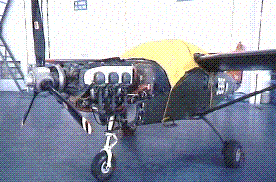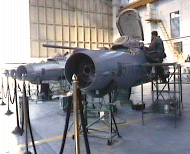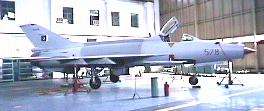Paul Lewis/KAMRA
When the Pakistan air force received its first Nanchang F-6 from China at the end of 1965, it quickly realised that a fighter with an 800h mean time between overhauls (TBO) would need to be supported locally if it was to avoid sending large numbers of its aircraft overseasfor extended periods. The decision was taken in 1972 to establish an F-6 Rebuild Factory, which has since grown into the sprawling Pakistan Aeronautical Complex (PAC).
The prolonged construction of the F-6 plant, with Chinese assistance, was quickly overtaken by the inauguration of the Mirage Rebuild Factory in 1978. It was established to overhaul Pakistan's Dassault Mirage III/5 fighters and their Snecma Atar 09C engines, and to avoid the expensive exercise of sending the jets to France, which the air force estimates would have cost close to $1.2 million apiece.

Two more factories have since sprouted atthe PAC, situated 100km (60 miles) north-west of Islamabad. The Aircraft Manufacturing Factory (AMF) opened in 1981, originally to licence-produce the Saab-designed MFI-17 trainer. It was followed two years later by the creation of an adjoining radar maintenance depot, which later became the Kamra Avionics and Radar Factory (KARF).
Grp Capt Ahmed Ishtiaq, staff officer to the PAC's director-general explains: "These four factories belong to the Ministry of Defence Production. They are administratively and financially independent factories, but, for the purposes of co-ordination, there is a directorate." About 48% of the PAC's 6,500 strong workforce is seconded from the air force, including virtually all of its senior management.
The F-6 plant is the largest of the four factories, employing 2,800 and with responsibility for the repair, overhaul and, in some cases, manufacture, of components and drop tanks for the air force's Chinese-built aircraft. Since completing its first aircraft in 1981, the plant has overhauled 265 F-6s and FT-5 trainers, 112 Nanchang A-5Cs and 55 Chengdu F-7Ps. Its capabilities have been extended to include tandem-seat Guizhou FT-7Ps, with the overhaul of the first two jets having been completed in November last year.
With most F-6s having been through three complete overhauls, the air force is faced with the choice of either carrying out a fourth rebuild, or replacing the type with new F-7MGs from China. "I've the option to go for another overhaul or phase them out. The cost of another overhaul is not economic. Slowly and gradually they'll go," concludes Air Chief Marshal Parvaiz Mehdi Qureshi, chief of the air staff.
The F-6 plant is accordingly shifting its main focus to supporting and upgrading the air force's 160 F-7Ps, the last of which was delivered in 1992. Each aircraft is completely rebuilt at the end of 800 flight hours, or roughly eight years of service. The fighter's Chinese-built WP7B powerplant has an even lower TBO than that of the airframe, and has to be sent to Karachi for an overhaul after only 200h.

F-7 airframe overhauls take around 30 weeks, entailing a complete disassembly of all components for workshop-level inspection and repair. Before being reassembled, Chinese electrics are replaced with new Raychem thermo-sealed wiring for better insulation, and all rubber seals and some of the F-7's hydraulic and fuel piping are also replaced. Work is expected to start this year on replacing the aircraft's old GEC-Marconi Skyranger 226 ranging-only radar with new Fiar Grifo 7 systems.

Project ROSE
In June last year, the adjacent Mirage Rebuild Factory completed the last cockpit upgrade for33 former Australian Mirage IIIEA/DAs as part of Project ROSE (retrofit of strike element). Work involved the installation of a Sagem integrated navigation/attack system, headup display, radar altimeter, multifunction displays and hands-on-throttle-and-stick controls. A planned second phase involves the installation of the Grifo M multimode radar, being flight tested at Kamra.
Kamra refurbished 45 of the 50 Australian Mirage IIIs acquired, with the 33 ROSE modified aircraft undergoing an inspection and the remaining 12 an overhaul. The plant performs two levels of overhaul: GV1 after 1,200h, or 12-14 years of flying, and GV2 at the end of 2,400-2,800h, or 24-26 years. The latter entails a more extensive 11-month work package, including a complete disassembly of the wing and fuselage, landing gear teardown, non-destructive testing and repair.
"We do everything, including structural modifications and repair and complete overhaul of the Atar 09C engine and all accessories. Nothing goes abroad apart from the fuel cells, which are rubber. We have the capability to repair them here, but there are some critical areas around the neck for which facilities are costly to establish," says Air Cdre Nasari, PAC acting director general and Mirage Rebuild Factory managing director.
The factory has inspected or overhauled 137 aircraft, including eight for the United Arab Emirates. Its work has been made none the easier by the increasingly diverse Mirage III/5 Êmarques being acquired by the air force, which, in addition to those originally purchased new by Pakistan, now include ex-Australian aircraft and, more recently, ex-French air force jets. Nasari estimates there is about 75-80% commonality between the different versions.
Atar light and general-level overhauls total more than 600. The Mirage Repair Factory also overhauls Pratt & Whitney F100-200 powerplants for the air force's Lockheed Martin F-16s. The plant is in the middle of upgrading the engines to the improved 220E standard, which entails 26 major modifications. It claims to have modified about one-quarter of the air force's F100 inventory.
The F-6 and Mirage factories are fitting all of the air force's front-line types with new chaff and flare dispensers and Chinese-designed BM/KJ8602 radar warning receivers produced locally by KARF. The avionics plant also supports the service's Siemens mobile pulse-Doppler radars and is expected to play a role in the Grifo 7/M radar upgrades.
Pakistan has been producing the MFI-17 primary trainer and light observation aircraft since 1975, with an initial 95 assembled from partly and completely knocked down kits supplied by Saab of Sweden.
In 1981, PAC bought the sole worldwide manufacturing rights to the aircraft from Sweden and has gone on to build indigenously a further 185 aircraft, locally named Mushshaks, for the Pakistan air force, army and navy, as well as for export to Egypt, Iran, Oman and Syria.
The AMF has developed an improved Super Mushshak variant, powered by a 195kW (260hp), Textron Lycoming IO-540-V4A5 with three-blade MacCauley propeller. Compared to the earlier 150kW, IO-360-powered Mushshak, the new two-seater offers improved speed, range, rate of climb and service ceiling. Other refinements include new instruments and cockpit air conditioning.
Air Cdre Raza, managing director of the AMF, says: "The next step is to begin series production of the Super Mushshak. Initially, we're going to build new aircraft and we have the capacity to produce up to 24 aircraft a year. The air force academy has also shown a great deal of interest in a retrofit for its 30-40 Mushshaks at Risalpur."
Karakoram plans
The AMF has produced five test and demonstrator aircraft, which the air force and army have evaluated and about which they are completing their reports. The factory is also trying to sell the Super Mushshak to Egypt, Jordan and Saudi Arabia. The plant, meanwhile, continues to support MF1-17s worldwide with spares, including those operated in Sweden.
The PAC has a 25% share in the airframe of the K-8 Karakoram jet trainer, which was jointly developed with Nanchang of China. It had originally intended assembling the tandem-seat jet locally with parts supplied from China, but this plan has been abandoned and the AMF instead plans to restrict itself to fabricating the vertical and horizontal stabilisers and front fuselage.
Only 15 K-8s have been produced, of which six were delivered to Pakistan for evaluation. A larger air force purchase hinges on the Chinese air force also ordering its own planned K-8J version of the trainer. It will be powered by the Russian Progress DV-2 in place of the AlliedSignal TFE731-2A turbofan, for which the US Government has refused to grant China a license to manufacture.
The K-8J will feature a wider and extended aft fuselage to accommodate the new engine. Pakistan plans to stick with the US powerplant and, as a result, the AMF has had to switch from manufacture of the K-8's rear cowling to the forward fuselage. In lieu of the Chinese air force ordering the jet, the AMF is optimistic of an export order from either Egypt or Myanmar to kick-start production.
The PAC freely admits to being "disappointed" with the K-8 impasse and has tried to get the air force to link its commitment to the Super 7 programme to a Chinese order for the trainer. "We're not making any headway with the K-8, but the air force may choose to look in the other direction and move with the Super 7 fighter, leaving the the trainer in limbo," says Ishtiaq.
Given the opportunity, Kamra would also like to share in the new Super 7 fighter programme and has already given input to the government for it to decide what is economically feasible to be conducted locally. Options vary from the complete assembly of the aircraft in Pakistan to the more likely role of producing structural or avionic components.
"We consider Kamra has matured to the level where it can go to the next stage and manufacture as a vendor for other industries around the world. Right now, our responsibilities are focused on overhaul, but we're now actively looking for opportunities with some of the aerospace giants, including a commercial revenue programme," says Ishtiaq.
Source: Flight International























